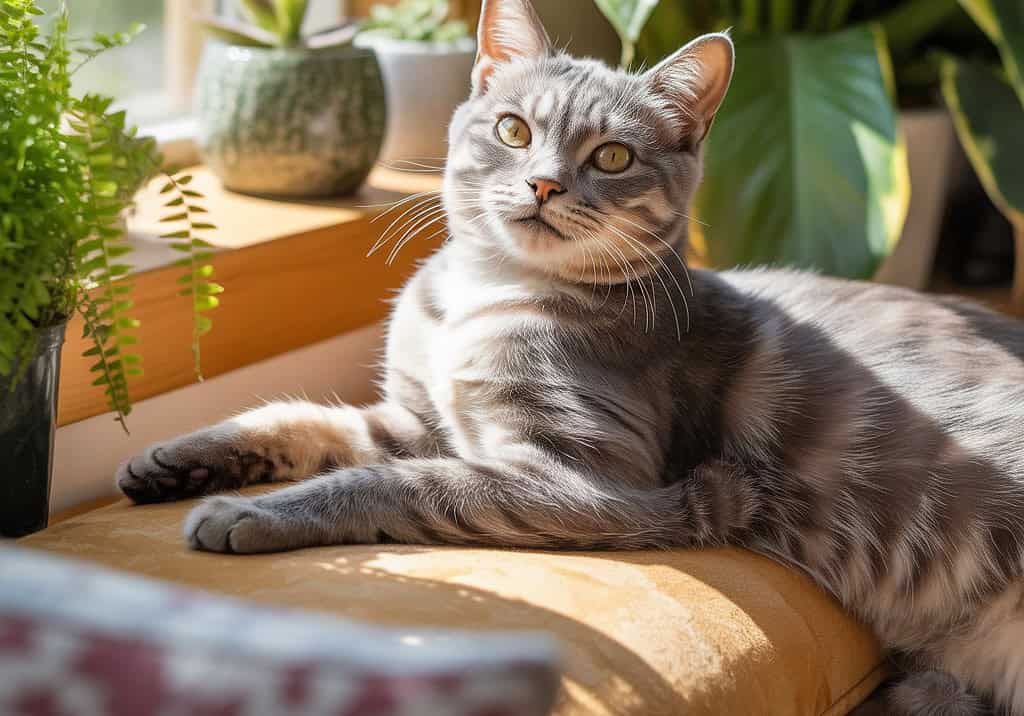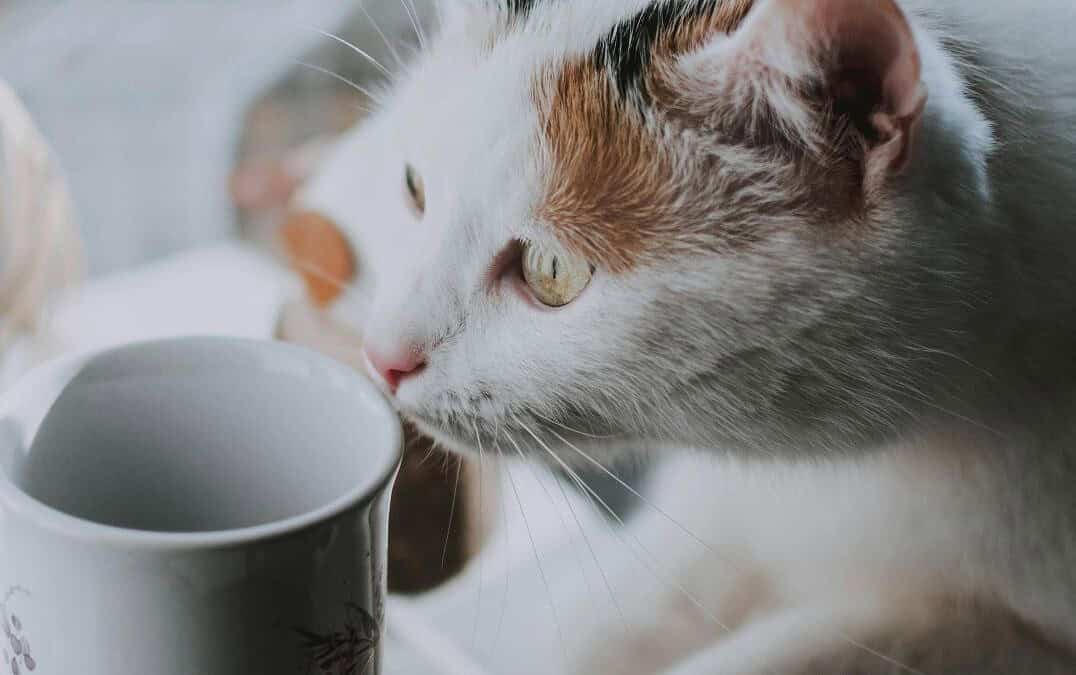As a cat owner, understanding your feline’s behavior is crucial to ensuring their happiness. Cats exhibit unique behaviors that can indicate their emotional state. Recognizing these signs can help you provide a more nurturing environment.
Cat happiness is often reflected in their daily activities and interactions. By paying attention to these signs of a happy cat, you can better understand your pet’s needs and strengthen your bond with them.
Key Takeaways
- Recognizing the behavioral clues of a happy cat.
- Understanding the importance of feline behavior.
- Identifying signs that indicate your cat’s happiness.
- Creating a nurturing environment for your cat.
- Strengthening your bond with your cat through understanding their behavior.
The Importance of Understanding Your Cat’s Emotional Wellbeing
Recognizing the emotional state of your cat is vital for providing the best possible care. Cats experience a range of emotions that can significantly impact their overall health and happiness.
Why Cat Happiness Affects Their Overall Health
A happy cat is more likely to be healthy and active. When cats are emotionally content, they tend to have better appetite, sleep patterns, and are more resilient to diseases. Stress and anxiety, on the other hand, can lead to various health issues, including digestive problems and skin conditions.
Understanding and promoting your cat’s emotional wellbeing can lead to a stronger bond between you and your pet, as well as a reduction in stress-related behaviors.
The Challenge of Reading Feline Emotions
Unlike humans, cats do not openly express their emotions. Reading feline emotions requires attention to subtle behavioral cues, such as body language and vocalizations. Cat owners often face challenges in interpreting these signs, which can lead to misunderstandings about their cat’s emotional state.
By learning to recognize these cues, cat owners can better understand their cat’s emotional wellbeing and take steps to ensure their cat leads a happy and healthy life.
How to Tell If Your Cat Is Happy: 8 Behavioral Clues
Cats often express their happiness through body language, and being able to read these signs is key to a healthy relationship with your pet. Understanding feline behavior can seem complex, but by focusing on specific indicators, you can gain insight into your cat’s emotional state.
The Subtle Art of Feline Body Language
Feline body language is a nuanced form of communication that includes a range of postures, facial expressions, and vocalizations. A happy cat will often display relaxed postures, such as lying on their side or back, indicating comfort and trust in their environment. These subtle cues can provide valuable information about your cat’s happiness.
Why These 8 Indicators Are Scientifically Reliable
The 8 behavioral clues we’ll explore are backed by scientific research into feline behavior and psychology. Studies have shown that certain behaviors are consistent indicators of happiness in cats, such as purring, kneading, and slow blinking. By understanding these behaviors, you can better assess your cat’s emotional wellbeing.
As noted by experts, “Cats exhibit specific behaviors when they are content, such as relaxed body language and positive vocalizations.”
“A cat that feels secure and happy will often show this through their behavior, such as through play or affectionate interactions.”
Recognizing these signs can help strengthen the bond between you and your cat.
Behavioral Clue #1: Purring and Vocal Communication
Understanding your cat’s vocalizations, including purring, can provide insights into their emotional state. Cats communicate in various ways, and their vocalizations are key indicators of their happiness and contentment.
The Different Types of Happy Purrs
Purring is a unique vocalization that cats make by using the laryngeal muscles to vibrate their vocal cords. This action results in the characteristic purring sound. Research suggests that purring is a sign of self-soothing and contentment in cats. However, not all purrs are the same; the context and tone can vary, indicating different emotional states.
For instance, a cat might purr when they’re feeling relaxed and happy, but they might also purr when they’re anxious or stressed. The difference lies in the tone and volume of the purr, with happy purrs typically being more rhythmic and softer.
Other Positive Vocalizations to Listen For
Beyond purring, cats use a range of other vocalizations to communicate happiness and contentment. Understanding these sounds can help you better connect with your cat.
Chirps and Trills
Some cats make chirping or trilling sounds when they see prey or are excited. These sounds are often a sign of happiness and excitement.
Soft Meows vs. Demanding Calls
Cats also use meowing to communicate. Soft meows can be a sign of affection or a request for interaction, while louder, more insistent meows can indicate a need or want, such as food or attention.
| Vocalization | Context | Interpretation |
|---|---|---|
| Purring | Relaxed environment | Contentment |
| Chirping/Trilling | Seeing prey or excitement | Happiness/Excitement |
| Soft Meowing | Affection or request for interaction | Affection/Need for interaction |
| Loud/Insistent Meowing | Need or want (food, attention) | Demand or need |
By paying attention to these vocalizations and their contexts, you can gain a deeper understanding of your cat’s emotional state and respond appropriately to their needs.
Behavioral Clue #2: Relaxed Body Language and Posture
When a cat is happy, its body language relaxes, signaling contentment to observant owners. A cat’s posture can reveal a lot about its emotional state, and understanding these cues can deepen the bond between cat and owner.
Tail Positions That Signal Contentment
A cat’s tail is a significant indicator of its mood. When a cat is happy, its tail often hangs relaxed, neither tucked between its legs nor held high in agitation. A gentle swish or a still, relaxed position can indicate contentment.
Relaxed Ears, Whiskers, and Muscles
Relaxed ears are another sign of a happy cat. When a cat feels comfortable, its ears are typically in a neutral position, not laid back in fear or perked up in alertness. Similarly, relaxed whiskers, which aren’t pulled back or forward, can indicate a calm state.
The “Loaf” Position
The “loaf” position, where a cat curls up with its paws tucked under its body, is a sign of deep relaxation and trust. This posture indicates that the cat feels safe and comfortable in its environment.
Belly Exposure and What It Means
When a cat exposes its belly, it’s a sign of ultimate trust and relaxation. A cat that feels secure will often roll onto its back, exposing its vulnerable underside. This behavior is a strong indicator of happiness and contentment.
| Body Language | Indication |
|---|---|
| Relaxed tail position | Contentment |
| Ears in neutral position | Relaxation |
| “Loaf” position | Deep relaxation and trust |
| Belly exposure | Ultimate trust and happiness |
By paying attention to these relaxed postures, cat owners can better understand their cat’s emotional state and ensure their pet is happy and content.
Behavioral Clue #3: Kneading Behavior or “Making Biscuits”
One of the most telling signs of a happy cat is its kneading behavior, also affectionately known as “making biscuits.” This behavior is not just a quirk; it has roots in the cat’s early developmental stages.
The Origins of Kneading in Kittens
Kneading originates from kittenhood, when cats used to stimulate milk production from their mothers by kneading their paws against their mother’s belly. This early behavior is crucial for their nutrition and comfort.
When and Where Cats Choose to Knead
As cats grow into adults, they continue to knead as a sign of comfort and relaxation. They often choose soft surfaces, such as laps, blankets, or even their owner’s bed, to knead on. The act of kneading can be accompanied by other signs of happiness, such as purring or relaxed body posture.
Kneading Combined With Other Happy Behaviors
When a cat kneads while displaying other happy behaviors, such as purring or having a relaxed facial expression, it’s a strong indication that the cat is feeling content and at ease. Observing these combined behaviors can give cat owners a clearer understanding of their cat’s emotional state.
In conclusion, kneading behavior is a significant indicator of a cat’s happiness, tracing back to the comfort and security of their kittenhood. By understanding and recognizing this behavior, cat owners can better appreciate their cat’s emotional wellbeing.
Behavioral Clue #4: Playfulness and Appropriate Energy Levels
Understanding the nuances of your cat’s play behavior can reveal a lot about their emotional wellbeing. Playfulness is a vital aspect of a cat’s behavior, indicating happiness and contentment.
Age-Appropriate Play Behaviors
Cats exhibit different types of play at various stages of their lives. Kittens engage in high-energy play, such as running and pouncing, which helps develop their motor skills. As cats mature, their play behavior evolves to include more strategic and stealthy actions, like stalking and ambushing toys.
It’s essential to recognize what constitutes normal play behavior for your cat’s age group. For instance, older cats may not be as energetic as younger ones but still enjoy gentle play.
The Difference Between Happy Play and Stress-Relief
Not all play behavior is a sign of happiness. Cats may also play as a way to relieve stress or anxiety. Happy play is typically characterized by relaxed body language, smooth movements, and a general air of contentment.
In contrast, stress-relief play may involve more frantic or aggressive actions. Understanding the context and your cat’s body language during play can help you distinguish between happy and stress-relief play.
Play Initiation as a Happiness Indicator
When a cat initiates play, it’s often a strong indicator of their happiness and trust in their environment. Cats that feel secure and comfortable are more likely to start playing, either with toys or with their human companions.
| Play Behavior Characteristics | Happy Play | Stress-Relief Play |
|---|---|---|
| Body Language | Relaxed, smooth movements | Frantic, tense movements |
| Energy Levels | Appropriate for age and health | Excessive or erratic |
| Initiation | Often initiated by the cat | May be triggered by stressors |
By observing your cat’s play behavior and understanding the differences between happy and stress-relief play, you can gain valuable insights into their emotional wellbeing.
Behavioral Clue #5: Healthy Appetite and Grooming Habits
A cat’s happiness can often be reflected in their daily habits, particularly their appetite and grooming behaviors. Healthy appetite and grooming habits are crucial indicators of a cat’s overall wellbeing.
Consistent Eating Patterns in Content Cats
Cats that are happy and content tend to have consistent eating patterns. A healthy appetite is a good sign that your cat is feeling well both physically and emotionally. Monitoring your cat’s food intake and observing their enthusiasm during meal times can provide insights into their happiness.
Self-Grooming as a Sign of Physical and Emotional Wellbeing
Grooming is a vital aspect of a cat’s daily routine, serving not only to keep their coat clean but also as a self-soothing behavior. Cats that are relaxed and happy tend to groom themselves regularly, indicating good physical and emotional health.
When Grooming Indicates Stress Instead of Happiness
While regular grooming is a sign of contentment, excessive grooming can be an indicator of stress or anxiety. It’s essential to differentiate between normal grooming behaviors and those that might signal underlying issues.
By paying attention to your cat’s eating habits and grooming behaviors, you can gain a better understanding of their emotional state and overall happiness.
Behavioral Clue #6: Slow Blinking and Positive Facial Expressions
Cats communicate happiness and trust through subtle facial cues, one of which is slow blinking. This behavior is often referred to as a “cat kiss,” signifying affection and comfort in the presence of their owners.
The “Cat Kiss” – Understanding Slow Blinks
Cats blink slowly when they feel relaxed and comfortable, signaling trust in their environment. This slow blink is akin to a human smile, conveying friendliness and approachability.
Relaxed Facial Muscles and Forward Whiskers
A happy cat displays relaxed facial muscles, observed through their soft, calm expression. Forward-pointing whiskers indicate a positive emotional state, showing curiosity and relaxation rather than fear or aggression.
How to Return the “Slow Blink” to Your Cat
To reciprocate your cat’s slow blink, look at your cat and blink slowly. This action strengthens your bond, mimicking their natural communication. By returning the slow blink, you’re signaling trust and comfort around your cat.
Engaging in this form of communication enhances your relationship, fostering deeper trust and understanding between you and your pet.
Behavioral Clue #7: Seeking Human Interaction and Affection
One of the most telling signs of a happy cat is their desire to engage with their human companions. Cats that feel secure and content in their environment are more likely to initiate interactions, showing affection in their unique ways.
Initiating Interaction
Happy cats often choose to interact with their humans through various behaviors. They may rub against legs, nuzzle hands, or even initiate play. These actions are not just signs of affection but also indicators of trust and comfort.
For example, a cat that voluntarily approaches you and rubs against your leg is showing a clear sign of affection and trust. This behavior is a leftover from kittenhood when they used to rub against their mothers. Now, it signifies that they feel safe and happy in your presence.
Respecting Individual Preferences
It’s crucial to understand that each cat has its own unique personality and social preferences. While some cats are very demanding of attention, others may be more aloof. Recognizing and respecting these individual differences is key to building a strong, positive relationship with your cat.
Observing your cat’s behavior and reactions to different types of interaction can help you tailor your approach to their preferences. Some cats may enjoy being petted or cuddled, while others might prefer playing or simply being near you without being touched.
Head Butts, Cheek Rubs, and Scent Marking
Specific behaviors like head butting and cheek rubbing are significant ways cats show affection and mark their territory. When a cat gently bumps their head against you or rubs their cheek on you, they are depositing their scent on you, effectively marking you as their own.
This behavior is a compliment, as it signifies that the cat feels comfortable enough to claim you as part of their territory. It’s also a way for them to mix their scent with yours, creating a shared scent that reinforces your bond.
| Behavior | Description | Significance |
|---|---|---|
| Head Butting | Gently bumping their head against a person | Sign of affection and scent marking |
| Cheek Rubbing | Rubbing their cheek against a person or object | Deposits scent, marks territory |
| Scent Marking | Leaving their scent on a person, object, or area | Claims ownership, establishes comfort and familiarity |
Behavioral Clue #8: Comfortable Sleeping Habits and Positions
Observing your cat’s sleeping positions and habits can provide valuable insights into their emotional wellbeing. Cats often display unique sleeping behaviors that can indicate their level of comfort and trust in their environment.
Vulnerable Sleeping Positions as Trust Indicators
Cats that feel secure in their surroundings may adopt vulnerable sleeping positions, such as lying on their back or exposing their belly. These positions indicate a high level of trust, as they make the cat more vulnerable to potential threats.
Vulnerable Sleeping Positions:
- Lying on their back
- Exposing their belly
- Sleeping with their legs stretched out
Sleep Location Choices in Content Cats
The location where a cat chooses to sleep can also be a significant indicator of their comfort level. Cats often prefer quiet, cozy spots, and their choice of sleeping location can reveal their sense of security and trust.
The Significance of Sleeping Near or On You
When a cat chooses to sleep near or on their owner, it is a strong indication of their trust and affection. This behavior signifies that the cat feels safe and comfortable in the owner’s presence.
| Sleep Location | Indication |
|---|---|
| Sleeping near or on the owner | Trust and affection |
| Quiet, cozy spots | Sense of security |
| Exposed or high-traffic areas | Potential stress or vigilance |
Conclusion: Becoming Fluent in Your Cat’s Happiness Language
Understanding your cat’s emotional wellbeing is crucial for building a strong, loving relationship. By recognizing the 8 behavioral clues to happiness, you can become fluent in your cat’s language and ensure their overall feline wellbeing.
Observing your cat’s behavior, from purring and vocal communication to comfortable sleeping habits, can provide valuable insights into their emotional state. By paying attention to these subtle cues, you can better understand your cat’s needs and create a nurturing environment that promotes happiness and contentment.
Becoming attuned to your cat’s happiness language not only enhances your understanding of their behavior but also strengthens your bond. As you learn to interpret their behavioral clues, you can respond in ways that support their emotional wellbeing, leading to a more fulfilling and joyful relationship between you and your cat.
By applying the knowledge gained from understanding cat behavior, you can make informed decisions to improve your cat’s quality of life, ultimately contributing to their overall feline wellbeing and happiness.









